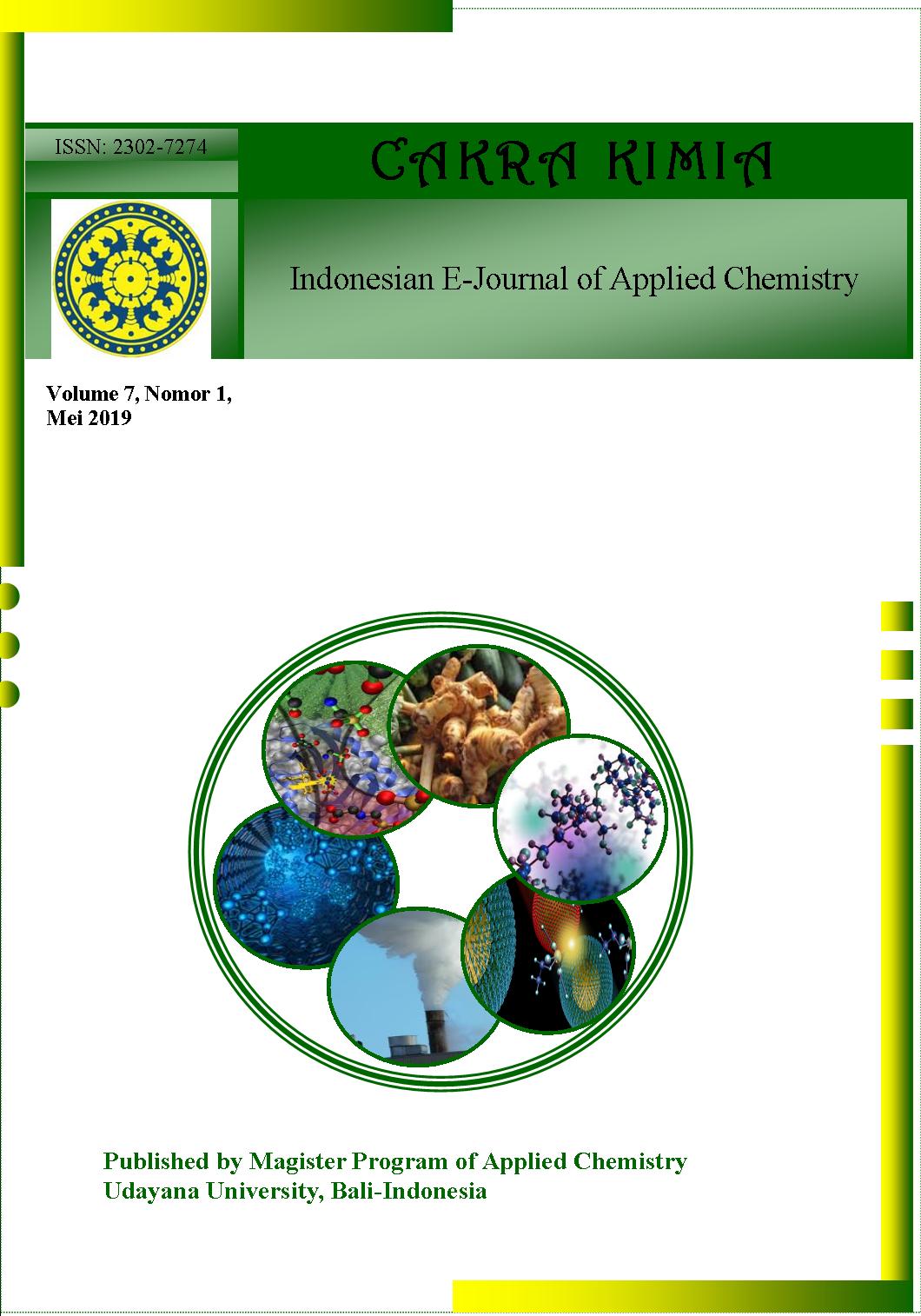SINTESIS SENYAWA 2-CYANOPROP-2-YL DITHIOBENZOATE SEBAGAI CHAIN TRANSFER AGENT PADA POLIMERISASI REVERSIBLE ADDITION-FRAGMENTATION CHAIN TRANSFER
Abstract
2-Cyanoprop-2-yl Dithiobenzoate merupakan salah satu transfer agen pada polimerisasi Reversible Addition-Fragmentation Chain Transfer (RAFT). Senyawa ini telah banyak digunakan dalam proses sintesis polimer yang diperuntukan dalam bidang kesehatan. Tujuan penelitian ini adalah untuk mensintesis 2-cyanoprop-2-yl dithiobenzoate. Senyawa tersebut disintesis elalui proses pembentukan senyawa asam ditiobenzoat dan di(tiobenzil) disulfida sebagai senyawa antara atau intermediet. Keberhasilan pembentukan senyawa target dipastikan dengan menggunakan Fourier Transform Infrared (FTIR) dan Nuclear Magnetic Resonance (13C-NMR dan 1H-NMR). Serapan pada bilangan gelombang 2239,36 cm-1 merupakan karakteristik untuk gugus (CN) dan serapan dengan bilangan gelombang 854 cm-1 dan 773 cm-1 merupakan karakteristik untuk gugus tiol (-C-SH). Sedangkan pada 1H-NMR terdapat serapan dengan pergeseran kimia 1,55 ppm yang mengindikasikan bahwa produk yang dihasilkan merupakan campuran. Spektra 1H-NMR memberikan pergeseran kimia pada 1,4 –1,7 ppm (proton CH3) dan 7,7 - 8,1 ppm (proton aromatik) . Spektra 13C-NMR memberikan pergeseran kimia 10,0 – 30,0 ppm (karbon CH3), 69,0 – 70,5 ppm (karbon OCH3), 120,00 – 121,00 ppm (karbon CN), 123,00 – 124,00 ppm (karbon S-C-CN), 130,00 – 140,00 ppm (karbon aromatik), dan 178,00 – 181,00 ppm (CS2). Dapat disimpulkan bahwa sintesis senyawa 2-cyanoprop-2-yl dithiobenzoate sudah berhasil dilakukan dengan rendemen sebesar 84,7%.
The purpose of this study was to synthesize 2-cyanoprop-2-yl dithiobenzoate, one of the transfer agents on Reversibble Addition-Fragmentation Chain Transfer (RAFT) polymerizations widely used in polymer synthesis processes intended for health purposes. The compound was synthesized through the formation of dithioobenzoic acid and di(thiobenzyl) disulfide as intermediate compounds. The confirmation of the reaction was conducted by Fourier Transform Infrared (FTIR) and Nuclear Magnetic Resonance (1H-NMR and 13C-NMR). The FTIR spectrum confirmed the formation of the target compound with some characteristic bands at 2289.36 cm-1 assigned for –CN and at 854 cm-1 and 773 cm-1 assigend for –CS group. Moreover, the 1H-NMR spectrum showed chemical shifts at 1.4 – 1.7 ppm and 7.7 – 8.1 pmm assigned for –CH3 and aromatic protons respectively. The 13C-NMR spectrum showing chemical shifts at 10.0 – 30.0 ppm (-CH3), 69.0 – 70.5 ppm (-OCH3), 120.0 – 121.0 ppm (-CN), 123.0 – 124.0 ppm (-S-C-CN), 130.0 – 140.0 ppm (aromatic carbons), and 178.0 – 181.0 ppm (-CS2-) also confirmed the formation of the target compound. It can be concluded that the synthesis of 2-cyanoprop-2-yl dithiobenzoate has been successfully carried out with a yield of 84.7%.
Downloads
References
[2] Moad, G., Chong, Y. K., Postma, A., Rizzardo, E., dan Thang, S. H., 2005. Advances in RAFT Polymerization: The Synthesis of Polymers with Defined End-Groups, Journal Polymer, 46 : 8458 - 8468
[3] Cui, W., Cheng, L., Li, H., Zhou, Y., Zhang, Y., and Chang, J., 2012. Preparation of Hydrophilic Poly(L-lactide) Electrospun Fibrous Scaffolds Modified with Chitosan for Enhanced Cell Biocompatibility, Journal Polymer 53 : 2298-2305
[4] Alam, M. Z., Shibahara, A., Ogata, T., dan Kurihara, S., 2011. Synthesis of Azobenzene-Functionalized Star Polymer via RAFT and Their Photoresponsive Properties, Journal polymer 52 : 3696-3703
[5] Radzevicius, P., Krivotorova, T., dan Makuska, R., 2016. Synthesis by One-Pot Raft Polymerization and Properties of Amphiphilic Penta-Block Copolymers with Repeating Blocks of Poly(2-hydroxyethyl methacrylate) and Poly(butyl methacrylate), European Polymer Journal 8 : 299-312
[6] Brouwer, H. D., 2001. RAFT memorabilia (Thesis), Universitas Eindhoven, Eindhoven.
[7] Keddie, D. J., Moad, G., Rizzardo, E., dan Thang, S. H., 2012. RAFT Agent Design and Synthesis, Australia, CSIRO Materials Science and Engineering
[8]Velasquez, E., Rieger, J., Stoffelbach, F., Agosto, F. D., Lansalot, M., Dufils, P. E., dan Vinas, J., 2016. Surfactant-Free Poly(vinylidene chloride) Latexes via One-Pot RAFT-Mediated Aqueous Polymerization, Journal polymer 8 : 83-
[9] Yu, B., Zeng, Z., Ren, Q., Chen, Y., Liang, M., dan Zou, H., 2016. Study On The Performance of Polycarboxylate-Based Superplasticizers Synthesized by Reversible Addition-Fragmentation Chain Transfer (RAFT) Polymerization, Journal of molecular structure 1120 : 171-179
[10] Albertin, L., Stenzel, M. H., Kowollik, C. B., dan Davis, T. P., 2005. Effect of an Added Base on (4-cyanopentanoic acid)-4-dithiobenzoate Mediated RAFT Polymerization in Water, Journal Polymer, 47 : 1011-1019
[11] Braunecker, W. A., dan Matyjaszewski, K., 2006. Controlled/Living Radical Polymerization: Features, Developments, and Perspectives, Journal Proggress in Polymer Science, 32 : 93-146
[12] Mitsukami, Y., Donovan, M. S., Lowe, A. B., dan Mccormick, C. L., 2001. Water-Soluble Polymers. 81. Direct Synthesis of Hydrophilic Styrenic-Based Homopolymers and Block Copolymers in Aqueous Solution via RAFT, Journal macromolecule 34 (7) : 2248 - 2256



 Petunjuk Penulisan
Petunjuk Penulisan
